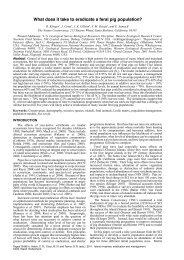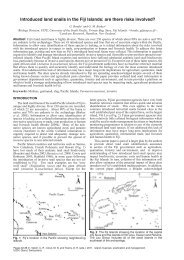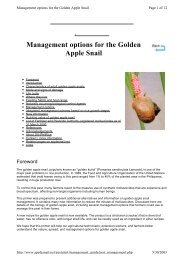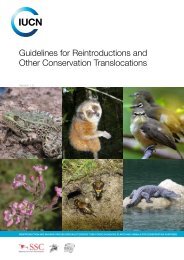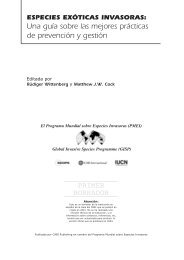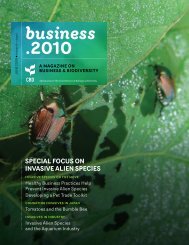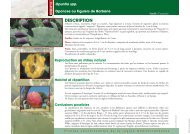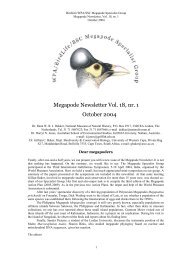Aliens Newsletter - ISSG
Aliens Newsletter - ISSG
Aliens Newsletter - ISSG
Create successful ePaper yourself
Turn your PDF publications into a flip-book with our unique Google optimized e-Paper software.
30<br />
25<br />
20<br />
15<br />
10<br />
5<br />
0<br />
1984<br />
1985<br />
The arrival of Ruddy Ducks in Europe<br />
As the UK population grew and its breeding range<br />
spread, increasing numbers of Ruddy Ducks began<br />
to appear in Europe, most notably in the countries<br />
adjoining the UK such as France, Belgium and the<br />
Netherlands. DNA analysis has confirmed that the<br />
European Ruddy Duck population is likely to derive<br />
solely from the captive population in the UK<br />
(Muñoz-Fuentes et al. 2006). Captive birds are also<br />
present in some European countries, but the close<br />
correlation between the rise in the UK population<br />
and the increase in records in mainland Europe suggests<br />
that escapes from captivity are not the main<br />
source of birds in Europe. In addition, the appearance<br />
of winter flocks of 30–40 birds in France (winter<br />
1995/96) and Spain (January 1997, following<br />
freezing conditions across northern Europe) cannot<br />
be explained by escapes from captivity (Hughes<br />
1996). By 1999 the breeding range of Ruddy Ducks<br />
in the UK included most suitable habitat in England<br />
and Wales as well as several areas of Scotland and<br />
parts of Ireland. By January 2000, the UK population<br />
was estimated at c. 6,000 birds (Kershaw &<br />
Hughes 2002). Annual breeding attempts were also<br />
believed to occur in at least six countries in the<br />
Western Palearctic, in addition to the UK: France,<br />
the Netherlands, Belgium, Ireland, Iceland and Morocco<br />
(Hughes 1999).<br />
The background to the eradication programme<br />
in the UK<br />
By the early 1990s, when the UK held around 95%<br />
of all the Ruddy Ducks in Europe, it had become<br />
1986<br />
1987<br />
1988<br />
1989<br />
1990<br />
1991<br />
1992<br />
1993<br />
1994<br />
1995<br />
1996<br />
1997<br />
1998<br />
1999<br />
Figure 4. Numbers of Ruddy Ducks recorded in Spain, 1984-2009<br />
2000<br />
2001<br />
2002<br />
2003<br />
2004<br />
2005<br />
2006<br />
2007<br />
2008<br />
2009<br />
clear that to do nothing would eventually allow Ruddy<br />
Ducks to spread through the continent. The Spanish<br />
authorities would then find it increasingly difficult<br />
to prevent the establishment of Ruddy Ducks<br />
with the attendant risk of increasing levels of hybridisation<br />
between Ruddy Ducks and White-headed<br />
Ducks. Given that White-headed Ducks in Spain<br />
are now protected from hunting and habitat loss, it<br />
is generally recognised that introgressive hybridisation<br />
with the Ruddy Duck is now the greatest longterm<br />
threat to the White-headed Duck (e.g. Hughes<br />
et al. 2006).<br />
The case of the Ruddy Duck is unique in that action<br />
has been taken in one country to protect a<br />
species in another. Ruddy Ducks were regarded by<br />
many as an attractive and harmless addition to the<br />
British avifauna, and to a lesser degree this remains<br />
the case. Many in the UK took the view that if the<br />
Ruddy Duck was a problem it should be dealt with<br />
in Spain. It was also highly uncertain whether control<br />
of Ruddy Ducks in the UK was feasible (particularly<br />
to the point of eradication), how much eradication<br />
might cost, and whether it would be acceptable<br />
to the general public. For these reasons the UK<br />
Government commissioned small-scale research into<br />
control in the early 1990s. This involved the<br />
culling of fewer than 100 birds per year and had no<br />
significant effect on the population, but the results<br />
indicated that breeding-season shooting was the<br />
most effective method of control, followed by winter<br />
shooting. Although nest trapping had a high intrinsic<br />
efficiency, the rate of control in terms of staff<br />
effort was very low and the method would therefore<br />
be an ineffective means of attempting eradication.<br />
The report concluded that eradication was feasible<br />
<strong>Aliens</strong> 19



